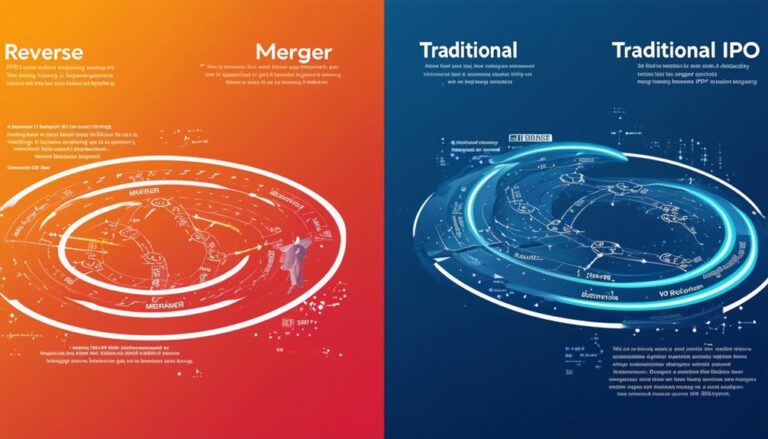Leveraging a Reverse Merger for Rapid Market Entry

Reverse mergers provide a strategic avenue for businesses to quickly enter the public markets. By utilizing the existing infrastructure and regulatory compliance of publicly traded shell entities, we can expedite our transition to a publicly traded company.
This cost-efficient approach helps us increase our visibility among potential investors and fast-track our expansion. Navigating the regulatory framework demands careful attention, yet the advantages of lower transaction costs, faster public listing, and simplified compliance procedures make reverse mergers an attractive option worth exploring.
To gain a comprehensive understanding and effectively carry out a reverse merger, let's delve deeper into the key considerations.
Key Takeaways
- Reverse mergers provide a cost-effective and expedited way for private companies to become publicly traded, enabling them to swiftly tap into the public capital markets.
- Conducting thorough financial and regulatory due diligence is essential to uncover any potential risks and ensure a smooth integration of the target company into the acquiring entity.
- By utilizing the existing infrastructure and reporting framework of the public company, the private entity can significantly reduce the administrative burden and compliance costs associated with going public.
- It is crucial to carefully evaluate the potential synergies and alignment between the acquiring private company and the target public entity to ensure a successful merger.
- Open and effective communication with stakeholders plays a vital role in addressing concerns related to transparency and credibility that are sometimes associated with reverse mergers, helping to manage market perception positively.
Understanding Reverse Mergers
A reverse merger is when a private company acquires a publicly traded company, allowing the private company to enter the stock market without going through the usual initial public offering (IPO) process. This method provides a quicker and more cost-effective way for companies to become publicly traded, leveraging the infrastructure and regulatory standing of the public company they acquire.
In a reverse merger, the owners of the private company become the majority shareholders of the public entity. It's essential to conduct thorough due diligence to ensure that both companies align strategically and comply with all relevant regulations.
By reorganizing the assets and operations of the public company, the private company can smoothly integrate its business and immediately reap the benefits of being a publicly traded company.
It is common for reverse mergers to target shell companies with minimal operations, as these public entities offer the necessary foundation for the private company to access the capital markets.
Benefits of Reverse Mergers
In the fast-paced world of business today, companies are increasingly opting for reverse mergers as a strategic route to going public. By simplifying regulatory obligations, cutting transaction costs, and expediting the process of becoming publicly listed, reverse mergers present an attractive alternative to the traditional initial public offerings (IPOs).
This method enables firms to swiftly tap into capital markets, improving their liquidity and funding prospects while bolstering their credibility and visibility in the eyes of potential investors and strategic allies.
Streamlined Regulatory Compliance
Reverse mergers simplify regulatory compliance by leveraging the public company's existing reporting structure. This reduces the burden on the private company entering the market. By acquiring a public shell company, startups benefit from the public company's compliance history and established reporting systems. This expedites market entry for startups by avoiding the lengthy and costly IPO regulatory process.
Public companies involved in reverse mergers have already met stringent regulatory requirements. Therefore, the private company doesn't have to start from scratch in navigating complex frameworks. Utilizing a reverse merger can significantly reduce the time and resources needed to comply with regulatory demands. This allows startups to focus on their core business operations and growth strategies rather than getting bogged down in bureaucratic red tape.
In essence, reverse mergers offer a streamlined path to public markets, empowering innovative companies to reach new heights more efficiently. The reduced regulatory burden enables startups to accelerate their market entry and capitalize on emerging opportunities.
Reduced Transaction Costs
By opting for a reverse merger instead of a traditional IPO, we can significantly reduce the costs associated with going public. Compared to the expensive fees linked to initial public offerings, reverse mergers offer a more cost-effective route to accessing the public markets. This cost savings can be a game-changer for both startups and established companies looking to lessen their financial burdens while still reaping the benefits of being publicly listed.
The streamlined processes and lower fees inherent in reverse mergers allow us to enter the public domain efficiently without facing the same financial strain as an IPO. This financial relief enables us to allocate resources more effectively towards driving our growth and fostering innovation, rather than exhausting our capital on excessive transaction costs.
Ultimately, the reduced transaction costs associated with reverse mergers empower us to concentrate on our core business goals, while also accelerating our access to public markets and the fundraising opportunities they offer.
Accelerated Public Listing
One major advantage of a reverse merger is the speedy process it offers in attaining public listing status, as opposed to the traditional IPO route. Through our experience, we've observed that the reverse merger path can significantly shorten the timeline by several months compared to a standard IPO.
This accelerated pace enables our company to promptly enter the capital markets. This swift transition to becoming a publicly traded entity boosts our credibility and visibility, drawing in potential investors eager to join our growth journey.
Disadvantages of Reverse Mergers

While reverse mergers can offer a quicker route to going public, they often present significant drawbacks that companies should carefully weigh. One major issue is the potential undervaluation of the acquired company, which can lead to discontent among shareholders due to substantial ownership dilution. Moreover, the perceived lack of transparency in the operations of the acquired firm may attract increased regulatory scrutiny, adding complexity to the process.
A critical concern is the negative market perception that can arise from using reverse mergers as a shortcut to public listings. Investors may see this approach as an attempt to sidestep the thoroughness of traditional IPOs, raising doubts about the company's credibility and long-term sustainability. Proactively addressing these concerns is crucial for companies looking to utilize reverse mergers while upholding shareholder confidence and a favorable market image.
Ultimately, deciding to pursue a reverse merger should be based on a thorough understanding of the potential risks and a comprehensive strategy to mitigate them. By carefully planning and maintaining transparency, companies can navigate the challenges and capitalize on the advantages of this expedited method for achieving a public listing.
Navigating Regulatory Compliance
When companies consider a reverse merger, it's essential to carefully review the regulatory requirements to ensure compliance. Understanding the disclosure obligations and considerations for shareholder approval is crucial for navigating this process successfully. By working closely with experienced legal advisors, we can confidently address the intricate regulatory framework and avoid potential pitfalls.
A reverse merger involves a private company merging with a publicly traded company to go public without an initial public offering (IPO). This method provides a faster and potentially less expensive way for a private company to become publicly traded. While the process can offer various benefits, such as access to capital markets and liquidity for existing shareholders, it also requires careful attention to regulatory compliance.
Disclosure obligations in a reverse merger typically involve providing detailed information about the transaction, the business operations of both companies, financial statements, and potential risks to investors. Shareholder approval considerations are also critical, as existing shareholders of the public company must often vote on the merger proposal.
Ensuring transparency and compliance with securities laws is paramount to the success of a reverse merger. By diligently assessing and meeting the regulatory requirements associated with a reverse merger, companies can proceed with confidence and minimize the risk of regulatory issues. Seeking guidance from legal experts who specialize in mergers and acquisitions can help navigate the complex regulatory landscape and ensure a smooth and compliant transaction.
Regulatory Requirements Evaluation
Understanding the regulatory landscape is crucial during a reverse merger to ensure compliance with securities laws and disclosure requirements. It's essential to navigate SEC reporting obligations effectively, including understanding filing deadlines, disclosure thresholds, and other regulatory nuances.
Seeking guidance from legal experts experienced in reverse mergers can provide valuable assistance in addressing complex regulatory challenges and avoiding costly mistakes.
Thoroughly reviewing material information disclosure is another critical aspect of regulatory compliance. Providing investors with all relevant details is necessary for them to make informed decisions. Collaborating closely with advisors to identify and accurately report on material developments is key to meeting disclosure obligations and building trust in the market.
Disclosure Obligations Compliance
Ensuring compliance with disclosure obligations is crucial in navigating the regulatory landscape of a reverse merger. It's essential to meticulously identify and report all material information to maintain transparency and uphold our commitment to shareholders. Failing to meet these requirements can result in legal consequences and harm our reputation.
By prioritizing regulatory compliance, we can assure that our company fulfills all legal obligations to safeguard our stakeholders. This includes providing timely and accurate disclosures regarding our financial status, operations, and potential risks. Transparency plays a vital role in establishing investor trust post-merger, and we're unwavering in our dedication to surpassing regulatory standards.
Our disclosure obligations necessitate a comprehensive understanding of the regulations outlined by entities such as the SEC. We're dedicated to utilizing this knowledge to remain compliant, enhancing our credibility and protecting the interests of our shareholders.
Through steadfast adherence to disclosure requirements, we're laying the groundwork for a successful reverse merger and swift entry into the market.
Shareholder Approval Considerations
Shareholder approval plays a pivotal role in our compliance strategy as we navigate the complexities of the reverse merger process. Transparency and regulatory adherence are our top priorities, and we achieve this by providing comprehensive disclosure to our shareholders.
In the reverse merger landscape, it's essential to disclose all material information to shareholders through proxy statements. These documents outline the merger terms and the potential impact on investor portfolios, enabling our shareholders to make well-informed decisions when casting their votes. Typically, a majority vote is required for the transaction to progress.
Working closely with regulatory bodies like the SEC, we ensure that our investor's interests are safeguarded and that we uphold the highest standards of fairness and compliance.
Financial Considerations for Reverse Mergers

When considering a reverse merger, it's crucial to thoroughly assess the target company's financial health, assets, and liabilities to determine potential synergies and growth opportunities for the merged entity. Reverse mergers can offer a cost-effective strategy for companies to quickly enter the market, but financial considerations should remain a top priority.
An in-depth examination of the target's balance sheet, income statement, and cash flow is necessary to evaluate its financial viability. Analyzing the value of the target's assets and understanding its outstanding liabilities will help in aligning the merger with strategic objectives. Moreover, potential cost savings and revenue enhancements resulting from the combination of the two organizations should be taken into account.
Conducting comprehensive due diligence is essential to uncover any hidden risks or warning signs. By carefully analyzing the financial data, an informed decision can be made regarding whether the reverse merger presents a valuable investment opportunity that will maximize shareholder value.
Strategic financial assessment is key to leveraging a reverse merger for successful market entry.
Assessing Reverse Merger Opportunities
When evaluating potential reverse merger opportunities, it's crucial to thoroughly examine the target company's financial stability, market position, and growth prospects to ensure they align with our strategic goals.
Comprehensive due diligence is essential, involving a deep dive into the target's regulatory adherence, legal standing, and operational effectiveness to uncover any possible hurdles.
Subsequently, we'll assess the synergies between our acquiring entity and the target to pinpoint areas for seamless integration post-merger.
It's important to consider how the market and potential investors might perceive the merger. Engaging proficient legal advisors to navigate the intricate regulatory landscape will help facilitate a smooth transaction process.
Executing a Successful Reverse Merger

Now that we've laid the groundwork for evaluating reverse merger opportunities, let's delve into the execution phase. The key to a successful transaction lies in seamlessly integrating the post-merger processes, which directly impacts the realization of synergies and the overall success of the endeavor.
To kick things off, conducting a comprehensive due diligence is crucial. This involves a thorough evaluation of the target company's financials, operations, and market position to ensure alignment with our strategic goals. By carefully assessing these aspects, we can develop integration strategies that facilitate a smooth transition while preserving and enhancing the value of the combined entities.
Navigating the legal and regulatory landscape is equally important. Compliance with all relevant rules and regulations is a top priority to maintain transparency and mitigate potential risks. Effective communication with stakeholders, including investors and employees, is essential for managing market perception and fostering trust throughout the process.
Future Trends in Reverse Mergers
Looking ahead, reverse mergers are set to play an increasingly strategic role for companies aiming for swift market entry and rapid growth. Driven by emerging trends, the landscape of reverse mergers is evolving, presenting businesses with fresh opportunities to gain a competitive edge and secure value.
Future trends in reverse mergers include:
- The ascent of reverse mergers as a tool for companies to bolster their environmental, social, and governance (ESG) profiles, aligning with societal expectations.
- The incorporation of advanced technologies like AI and automation to enhance post-merger operations and drive efficiencies.
- The growing use of reverse mergers as a transformative tactic, allowing companies to revamp themselves and seize new market opportunities.
- The importance of thorough due diligence and a deep understanding of regulatory and legal considerations for successful reverse merger implementation.
- The emergence of reverse mergers as a route for companies to access fresh capital and support their growth aspirations.
Frequently Asked Questions
What Are Some Examples of Successful Reverse Mergers?
We've witnessed some remarkable instances of successful reverse mergers, such as Marvel, Tesla, and Kraft Heinz. These companies leveraged the strategy to swiftly enter the market and capitalize on synergies. Despite the inherent challenges, a thorough evaluation of risks and meticulous integration planning can amplify the advantages of this innovative approach.
Is It Good to Do a Reverse Merger?
A reverse merger can be a game-changer for companies looking to make a big move in the market. However, it's important to approach this strategy with caution. Delving into the details of valuations, regulations, and the process of integration is crucial to ensure a successful outcome.
Reverse mergers can offer a unique opportunity for firms to quickly gain access to public markets, bypassing the traditional initial public offering (IPO) process. This can be particularly advantageous for companies looking to raise capital or enhance their visibility without going through the rigorous IPO process.
Despite the potential benefits, it's essential for companies to thoroughly evaluate the risks and complexities associated with reverse mergers. Due diligence is key to understanding the financial health of the target company, assessing regulatory compliance, and identifying any potential red flags that could impact the success of the merger.
What Are Reverse Merger Strategies?
We carefully analyze different types of mergers and acquisitions, including reverse mergers. Our team conducts thorough research, manages transaction timelines, optimizes capital structure, and addresses accounting implications to ensure compliance and unlock the full potential of this innovative approach for swift market entry. Reverse mergers can be a strategic method for companies to enter the market quickly and efficiently. They involve a private company merging with a public company, allowing the private company to become public without going through the traditional IPO process. This can provide a faster route to access capital markets and increase visibility in the market.
What Happens to My Stock in a Reverse Merger?
Just like a phoenix rising from the ashes, our stock's value in a reverse merger can either soar to new heights or plummet to unforeseen lows. It's truly a high-stakes game where understanding the legal, accounting, and market implications is crucial to safeguarding our shareholder rights.
In a reverse merger, a private company merges with a publicly traded company, allowing the private company to go public without the need for an initial public offering (IPO). This can lead to significant fluctuations in the stock price as the market reacts to the newly combined entity.
Investors should be aware of the risks involved in a reverse merger, as the stock price can be volatile post-merger. It's essential to conduct thorough due diligence on the companies involved, the financial health of the merged entity, and the potential for future growth.
Conclusion
Reverse mergers serve as a potent tool for swiftly entering novel markets and securing a public listing. Despite the distinct challenges they present, astute organizations that meticulously strategize and execute these transactions can reap substantial rewards that outweigh the associated risks.
In an ever-evolving landscape of reverse mergers, forward-thinking companies that proactively adapt will stand ready to capitalize on opportunities and outpace their rivals.





